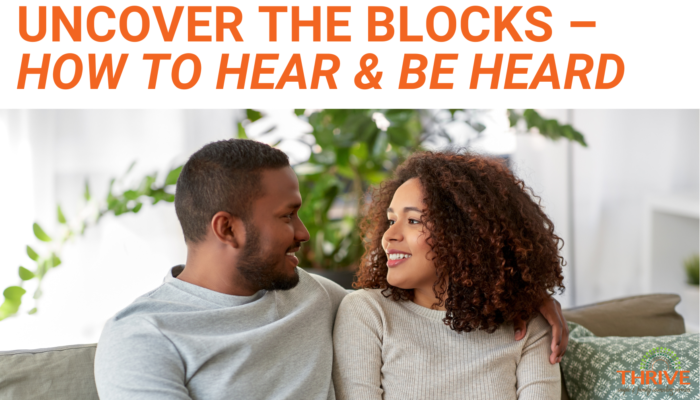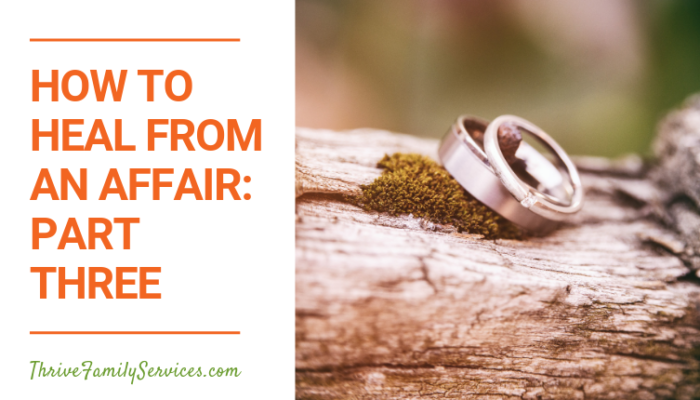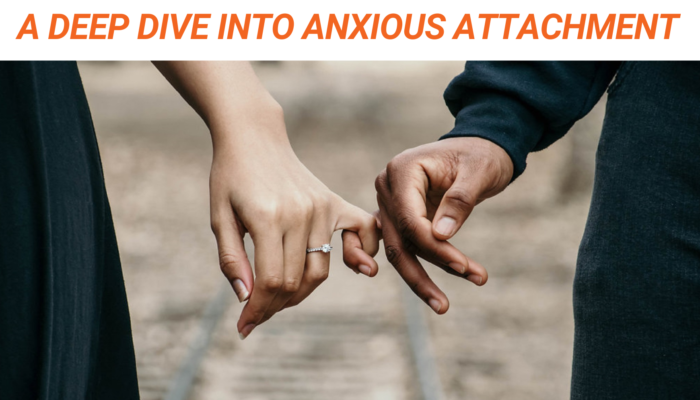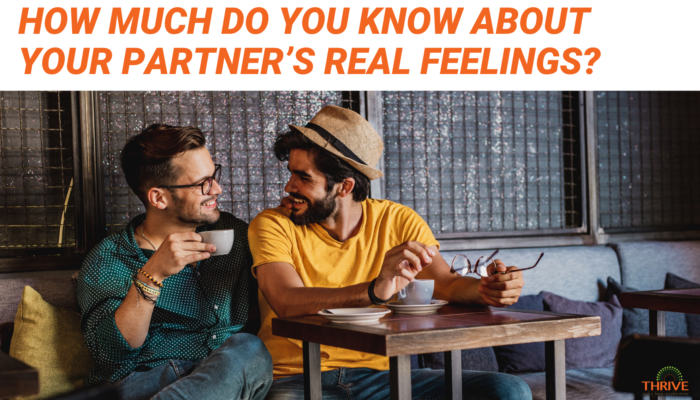“The only difference between master couples and disaster couples is the ability to have repair conversations.” – George Faller, LMFT, Emotionally Focused Therapy Trainer
You may have completed the first stage of Emotionally Focused Therapy where our goal is to help you begin to identify and de-escalate the negative cycle that has been creating disconnection and conflict.
Perhaps you are starting to feel some relief, understanding, and even compassion for your partner. All of a sudden, without warning, an emotion zaps you!
While listening to your partner, you suddenly get hung up on your own reactive emotions and react defensively.
How does this happen so fast to us when we are trying so hard to slow down, dig in, and understand our most important person? The answer lies in figuring out our blocks.
Blocks in Relationships
So, what is a block? A block stands between hearing your partner and responding with compassion, understanding, or in response to a need.
Blocks come when we least expect them and derail our conversations. After they happen, we are left feeling disheveled, thrown off, and asking ourselves, “What just happened?”
Color Coding Relationship Blocks
To break down how blocks appear, EFT Trainer George Faller, LMFT, has developed a system where we can locate and categorize Green Light, Yellow Light, and Red Light Blocks.
I’ll let you in on a secret: determining blocks is how your therapist reads the room in session and starts to determine how open each partner is towards the other’s experience. When a therapist interrupts, we are usually attending to a block in some way or another.
Let’s take some time to look at each blocking style and how it can impact your relationship.
Green Light Blocks (“I’ll fix it!”)
Green Light Blocks appear on the surface to be very positive. One partner feels the others’ pain so acutely that they want to rush in to save them from the pain. When things get sad, fearful, anxious, or intense, a Green Light Block sounds something like this,
- “Oh honey, don’t worry. Things have been getting so much better.”
- “I don’t want you to be afraid. It’s going to be okay.”
These are amazingly kind statements and protective in nature. The Green Light Blocked partner wants to ensure their partner is okay and swoops in to make the difficult emotion feel better.
Yet, here in this space, the hurting partner may hear that it’s not okay to display their full range of emotions. Inadvertently, your partner may hear that they should just put away these “problematic” emotions and “cheer up” instead.
Remember that these words from the Green Light Blocked partner are expressed with great care and kind intent. The Green Light Block also comes from a protective response where the blocked partner may feel like it’s a little too scary to feel or talk about these intense expressions.
We just need to keep reminding ourselves to open up the space, so all emotions are welcome, even when they are complicated to struggle through.
Yellow Light Blocks (“Yes, but…”)
A Yellow Light Block is best discussed using “parts” language. Parts language is just as it sounds: different “parts” of us feel different emotions. A part of the Yellow Blocked partner wants to hear and has compassion for their partner’s difficult emotions. This first part can sound like:
- “A part of me feels terrible that you feel alone.”
- “It has to be so difficult to feel you need to walk on eggshells around me.”
BUT (and watch for the but!), another part of the Yellow Light Blocked partner’s experience is protective and defensive.
In the moments of greatest need, the Yellow Light Blocked partner’s own experience is coming up and blocking the fullness of responsiveness or compassion they might feel for their partner.
The blocked partner may feel like they don’t want to be forgotten about, don’t yet feel understood, or that their own hurt is still not seen. This block would sound something like this:
- “I can’t imagine what it would feel like for you to feel alone, but think of how freaked out it makes me when you are upset.”
- “I’m so sad you are afraid to get into a conflict with me, but I’m so frustrated you can’t come to me. It makes me feel like a monster!”
Parts language is helpful because, as complex human beings with multi-layered emotions, we often feel multiple things simultaneously. This can feel confusing in the moment.
Suppose we can pick apart the opposing feelings within ourselves and see our Yellow Light Blocks when they come. We can then have that conversation with our partner that will help us to empathize with them before entering into our own experience.
The goal here is to sit with our partner’s emotions until we truly understand and they feel seen and heard.
Red Light Blocks (“No way!”)
Finally, and most outwardly impactful to our partners, are Red Light Blocks. Red Light Blocks are what you would imagine them to be.
One partner is sharing their experience, and the other partner comes in without being able to feel compassion or understanding for what was just shared. Red Light Blocks most likely led you into therapy. After one partner conveys emotion, a Red Light Block may sound like:
- “You never stay and talk it out. It’s like you don’t even care.”
- “You are way too emotional. “You need to just settle down.”
- “Don’t take your problems out on me!”
- “Why do I even try with you? You’ll never understand.”
Red Light Blocks can sound like advice, blaming, or condescension. They don’t feel good, yet, we have all had moments in intense fights where all we are feeding one another is Red Light Blocks.
These blocks can indicate Fight or Flight mode: one of us will Pursue and attack, and another will Withdraw and flee. It feels terrible at the time, and we inherently know that not much good will come from continuing this conversation in a Red Light Block zone. But what do we do when we are so weary and frustrated?
The great news is that your therapist is there to help interpret the Red Light Blocks for both of you, slow down the cycle, and put it back together in a way that makes sense, emotionally and logically.
Emotionally Focused Therapy is called that for a reason; not only are these intense emotions shared, but your therapist can help you focus on where those Red Light Blocks are cutting into your relationship’s sense of vulnerability and accessibility.
Understanding Intent Vs. Impact with Blocks
Finally, in understanding our blocks, it’s essential to look at the intent of our words and behavior vs. the impact of our response on our partner. Many times, we don’t want to hurt our partner. We intend to work it out, protect or pursue them, and keep our connection. Yet it is crucial to look at blocks’ impact on our relationship. For example:
- In Green Light Blocks –
- Our intent is to help our partner, protect ourselves, and calm down the emotion.
- The impact is that our partner’s emotion is given boundaries and not allowed to be expressed fully.
- In Yellow Light Blocks –
- Our intent is to try and balance perspectives to get back on track in our relationship.
- The impact is that we continue to go back and forth, presenting our sides of the story. Yellow Light Blocking doesn’t allow us to sink into our partner’s emotional context, understand them, and be fully understood.
- In Red Light Blocks –
- Our intent is usually to re-establish order, protection, and connection.
- The impact, however, is that our partner is either left alone or made to feel like they are the problem.
Intent and impact are crucial pieces of building compassion and understanding our blocks.
What Can You Do to Own Your Part and Work With Your Blocks?
As you get reattuned to yourself and your partner throughout the therapy process, you can start to name your blocks. Here’s a brief assessment to consider which block may be coming up for you in the moment:
GREEN LIGHT BLOCK
- Was I trying to keep my partner or myself from feeling intense or scary emotions?
- Did I focus on the positive rather than whatever sentiment they expressed?
- Did I jump in with logic so my partner would think about the emotion differently?
- Was I trying to fix the problem so my partner didn’t feel this heavy emotion?
YELLOW LIGHT BLOCK
- Was I caught up in something that happened earlier, and was it hard to hear my partner fully?
- Did I feel torn between understanding my partner’s perspective and sharing my own?
- While I understood my partner’s pain, did I feel compelled to explain my own, so they understood me too?
- Did I feel pain for my partner but also defensive and the need to explain my actions?
RED LIGHT BLOCK
- Did I feel my body get hot or a rush of energy to my head and chest?
- Did I experience a “punch to the gut” and a drop in my stomach?
- Did I have an emotion that felt like it “took over” the room and my actions?
- Did I react with immediate anger or the instant need to get out?
The Takeaway on Relationship Blocks
As you spend time with your spouse or partner (or child, companion, or family member) today, see what blocks come up for you. Slow down and ask yourself if it sounds like a Green Light, Yellow Light, or Red Light Block.
Talk to your partner about what’s happening inside, and bring your block experience to your next therapy session. As we collaborate, you and your therapist can articulate what keeps you feeling disconnected and find the way forward so you can be fully heard and understood. Your partner deserves it, and so do you!
References
- Adapted from: Elana Katz, LCSW, LMFT & George Faller, LMFT, Core Skills: Emotionally Focused Therapy Advanced Training




